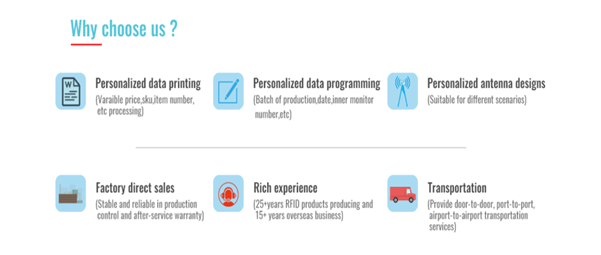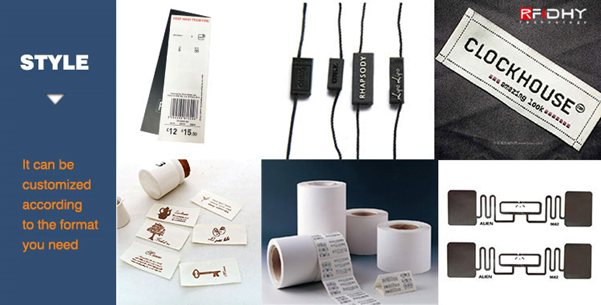Les industries de la ligne et du vêtement ont été les premières à appliquer la technologie RFID pour réduire le délai entre la fabrication et la vente au détail..
Identification radiofréquence (RFID) la technologie s'est avérée être un sauveur pour l'industrie de la mode en évolution rapide en rationalisant leurs opérations et en améliorant l'efficacité.
Comment fonctionnent les étiquettes de vêtements RFID?
Identification radiofréquence (RFID) la technologie utilise des ondes radio pour capturer numériquement des données avec une intervention manuelle minimale. Le système d'étiquetage RFID est similaire au code-barres avec des avantages supplémentaires par rapport à celui-ci.
La technologie RFID utilise des ondes radio pour identifier automatiquement les objets, collecter des données à leur sujet, et entrez ces données directement dans les systèmes informatiques avec peu ou pas d'intervention humaine. Une machine RFID typique comporte trois composants: Étiquette RFID, Lecteur RFID et l'antenne. Les étiquettes RFID contiennent un numéro unique et d'autres détails qui sont capturés par le lecteur et transformés en données qui sont enregistrées dans les ordinateurs.
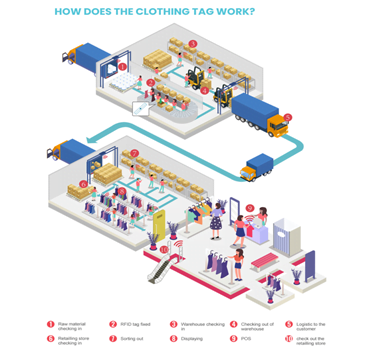
Quelle est l'utilisation des étiquettes RFID dans l'industrie du vêtement?
La RFID offre un meilleur contrôle et une meilleure visibilité à chaque étape de la chaîne d'approvisionnement. Les entreprises peuvent contrôler strictement la production, vente et stockage tout au long de la chaîne à différents endroits sans ressources humaines minimales. Les industries de l'habillement maintiennent des stocks importants difficiles à gérer manuellement. La technologie RFID permet à ces entreprises d'améliorer leur efficacité, réduire la consommation de temps et minimiser les erreurs humaines.
Améliore la qualité: L'industrie de l'habillement souffre beaucoup des dommages causés aux produits et des produits contrefaits. Il n'est pas facile d'identifier manuellement chaque produit endommagé. Le marquage RFID aide à suivre la marchandise de la fabrication au stockage et permet de détecter tout dommage à chaque point de contrôle.
Meilleur contrôle des stocks: Le marquage RFID aide le vendeur à localiser son stock de ligne. Ils peuvent rapidement savoir où une ligne est stockée et également réapprovisionner de manière proactive un style particulier avant qu'il ne soit complètement épuisé.. Le marquage RFID aide à suivre quel style évolue rapidement et quels modèles sont les plus demandés. Dans le scénario de la chaîne d'approvisionnement en évolution rapide, L'étiquetage RFID fait le travail en quelques secondes et maintient le fabricant et le vendeur prêts avec leur stock à temps.
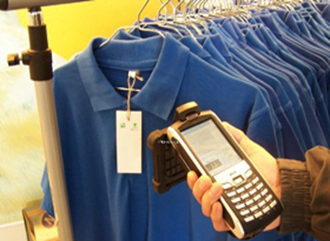
Contrôle et visibilité accrus: Le marquage RFID offre un meilleur contrôle et une meilleure visibilité que les codes-barres car le stock est automatiquement suivi et surveillé à chaque étape de la chaîne d'approvisionnement. Les entreprises peuvent facilement détecter les produits manquants et suivre les dommages.
Longue durée: Les étiquettes et codes-barres traditionnels peuvent être altérés et endommagés en raison de l'usure. Mais, Les étiquettes RFID sont très durables et durables. Ils ne sont pas endommagés dans un environnement difficile, chaleur, saleté et boue.
Suivi large gamme: Les étiquettes et codes-barres traditionnels nécessitent un lecteur pour lire manuellement chaque code-barres. Alors que, Le lecteur RFID peut scanner plusieurs étiquettes même à une distance de 100 pieds. La RFID ne nécessite pas de ligne de site. Cela rend le processus rapide et fiable.
Les balises sont durables et supportent dans un environnement difficile: Les étiquettes RFID ont une puce dédiée avec un numéro unique qui ne peut pas être copié. Les systèmes traditionnels et les codes-barres sont vulnérables aux violations de données et aux erreurs d'enregistrement. Tout le monde peut facilement dupliquer un code-barres. Les étiquettes RFID offrent un cryptage avancé des données que les pirates ne peuvent pas copier. Il réduit également les risques d'éléments manqués lorsqu'il est utilisé pour collecter des données sur un grand nombre d'éléments à la fois, minimisant ainsi les risques d'erreur humaine.
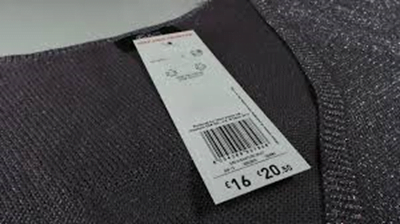
Antivol: Le lecteur RFID a une fonction de sortie relais. Lorsque le lecteur lit une étiquette spécifique, il ferme le relais déclenchant la fermeture du relais externe et active l'indicateur d'alarme.
Faible coût d'exploitation: Le système d'étiquetage RFID est moins coûteux et prend moins de temps que le système traditionnel. Les enregistrements de données RFID aident à suivre la santé de l'animal et la propagation de toute maladie. Aussi, Les enregistrements de données RFID aident à suivre la santé de l'animal et la propagation de toute maladie. Les enregistrements de données RFID aident à suivre la santé de l'animal et la propagation de toute maladie, Les enregistrements de données RFID aident à suivre la santé de l'animal et la propagation de toute maladie. Les enregistrements de données RFID aident à suivre la santé de l'animal et la propagation de toute maladie, un énorme stock de biens et d'actifs peut être scanné avec des ressources humaines et une logistique limitées.
Processus plus court: Avec code-barres, le lecteur doit scanner chaque objet un par un, ce qui rend le processus long. Mais, avec RFID, des milliers d'étiquettes peuvent être scannées en quelques secondes, ce qui réduit considérablement le temps de fonctionnement. Aussi, La technologie RFID peut être intégrée à d'autres technologies de fabrication et de chaîne d'approvisionnement et le délai entre la commande et la livraison peut être considérablement réduit.
Capacité de lecture/écriture: Un code-barres n'est lisible qu'une fois imprimé, les données sur l'étiquette du code-barres ne peuvent pas être modifiées. Mais, Les étiquettes RFID peuvent être lues et modifiées à tout moment.
Les étiquettes RFID stockent plus de données: Par rapport aux étiquettes et codes-barres traditionnels. Les étiquettes RFID peuvent stocker plus de données dans la mémoire non volatile.
La RFID peut être appliquée avec un code-barres: Si vous utilisez des codes-barres et que vous souhaitez passer à la RFID, ou souhaitez utiliser les deux simultanément. Vous pouvez facilement attacher des étiquettes en papier imprimables aux étiquettes RFID.
RFIDHY combine des technologies RFID innovantes avec des décennies d'expertise complète dans les étiquettes et étiquettes de vêtements pour offrir le meilleur de sa catégorie, des solutions d'affaires adaptées à nos clients. Chaque étiquette et étiquette de vêtement RFID contient des informations stockées électroniquement, y compris le type de produit, Taille, couleur et diverses autres fonctions d'identification et de suivi.
Toutes nos étiquettes de vêtements RFID offrent une authentification des produits plus rapide et plus efficace, réduire le risque de produits perdus ou contrefaits, et une visibilité complète sur toute la chaîne d'approvisionnement mondiale en temps réel.
